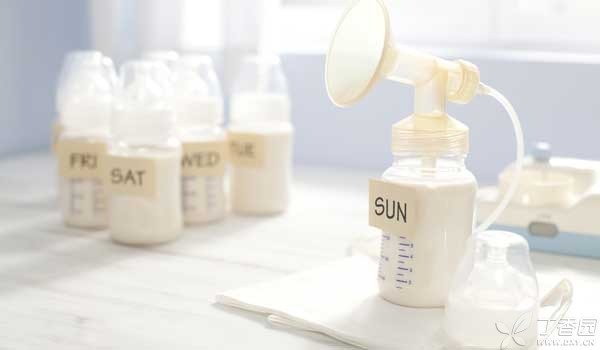
Every year, May 20 is the National Breastfeeding Day. The establishment of such a festival shows on the one hand that breast-feeding is very important, and on the other hand, it also shows that the current situation of insisting on breast-feeding is not optimistic. There is no need to say much about the benefits of breast-feeding to babies and mothers, but it is also difficult and doubtful to stick to it. As the saying goes, mastering methods can get twice the result with half the effort, so Clove Mother carefully sorted out some common problems about breast-feeding to see if they have solved your questions.
The baby eats well and the mother is at ease.
Q: There is very little breast milk in the first two days after birth. Do you need formula milk?
A: On the first day after the baby is born, the breast-fed baby can eat 2 ~ 10 mL of breast milk every time he breast-feeds, once every 2 ~ 3 hours, 8 ~ 12 times a day. The baby has at least 1 black-green stool and 1 urination. The next day, the baby will eat about 5 ~ 15 mL of milk each time, or 8 ~ 12 times. The baby has at least 3 black-green soft stool and 2 urinations. As long as the baby’s defecation and urination are normal, no formula milk is needed.
Q: How do you know if there is enough milk?
A: Whether the milk quantity is enough can be seen through the frequency of defecation and urination and the weight change of the baby.
-
The number of defecation and urination: after the 4th day of birth, the baby has at least 6 ~ 8 times of urination and 2 ~ 5 times of yellow defecation every day. Some babies will reduce the number of defecation after birth for about 1 month, even a few days to solve it once, but each time the amount is a lot, which may also be normal.
-
Weight change: The average baby’s weight drops to the lowest level two or three days after birth. If the weight loss exceeds 7%, you need to ask a doctor or lactation expert to have a look at what. After the 5th day, the average baby can grow 20 ~ 30 g per day and recover to the weight at birth 10 ~ 14 days after birth. Then the baby will grow 120 ~ 210 g per week.

Q: Is the correct breast-feeding posture what?
A: Except for the first few days after delivery, It is best for the mother to sit in a sitting position when nursing, Hold the baby to your chest, Let the baby’s head and upper body rest on one arm of the mother, let the baby’s whole body face the mother, hold up the whole breast with the other hand, and tease the baby’s mouth with nipples. The baby will open its mouth due to sucking reflex. At this time, the nipples and areola will be sent to the baby’s mouth, so that the baby can fully contain the mother’s nipples.
Q: How can the baby not spit milk?
A: The following methods can avoid spitting milk as much as possible:
-
After feeding the milk, hold the baby vertically for 15 ~ 30 minutes, and do not tease the baby immediately.
-
Try to be quiet and calm every time you nurse. Bathing or changing diapers should be carried out before feeding.
-
Grasp the time and frequency of nursing, and try not to nurse when the baby is extremely hungry.
-
If the baby spits milk frequently, the amount of milk fed each time should not be too much, but a small amount for many times.
-
Raise the upper body and let the baby sleep on his back, which can prevent suffocation caused by spitting milk after falling asleep.
Q: Do exclusively breast-fed babies need water?
A: Generally speaking, babies who are exclusively breast-fed do not need extra water before adding supplementary foods. Only under special circumstances, such as diarrhea and fever, need extra water according to the degree of dehydration of the baby.
Q: The baby has jaundice. Do you want to stop breast milk?
A: If it is not jaundice caused by breast milk itself, instead of stopping breast milk, increase the amount and frequency of breast milk, find a more suitable breast-feeding posture for the baby, and eat more milk, the jaundice of the baby can subside as soon as possible.
If it is breast milk jaundice, it needs to be judged by pediatricians according to the degree of baby jaundice. If the degree of jaundice is relatively mild, not only does it not need to stop breast milk, but also the number of breast feeding should be appropriately increased.
Q: It is more appropriate to feed breast milk to what?
A: The World Health Organization (WHO) recommends that exclusive breastfeeding for 6 months is the best way to feed infants. It is best for mothers to continue breastfeeding until the age of 2 or more after the baby is supplemented with supplementary foods.
Mother is ill, does it affect breast milk?
Q: Can my mother continue breast-feeding after catching a cold?
A: The common cold has no effect on breast-feeding, but some compound cold medicines may affect breast-feeding secretion. Lactating mothers should be careful when choosing cold medicines.
Q: Can I still feed breast milk with acute mastitis?
A: Acute mastitis is commonly known as milk accumulation, Stopping breastfeeding not only affects the feeding of infants, It will aggravate the possibility of milk deposition, It is not recommended to stop breastfeeding. In the early stage of acute mastitis, If there is only local distending pain and other feelings, Should let the baby suck the side breast more frequently, discharge the accumulated milk. However, if there is a lump, and there is local redness, or adults have fever symptoms, there may be abscess formation, it is recommended to suspend breast feeding on the affected side, use a breast pump to suck out the milk on the affected side breast, and encourage the use of healthy side breast to continue feeding. After recovery, the affected breast can continue to breast-feed.
Patients with acute mastitis should tell the doctor their wish to continue nursing when seeing a doctor, so as to facilitate the doctor to give advice.

Q: You need to take medicine during breastfeeding. How can it have the least impact on your baby?
A: If you need to take medicine during breastfeeding, try to observe the following principles:
-
The nursing mother must tell the doctor that you are nursing and must fully communicate with the doctor.
-
Choose topical drugs instead of oral drugs as much as possible, such as creams, ointments, lotions, suppositories for vagina or rectum. Local drugs enter milk in a small dose, which can effectively reduce the impact on the baby.
-
Mothers can take drugs that are not harmful to breast-feeding babies directly, but it should be noted that drugs that are not harmful to babies during pregnancy may affect breast-feeding babies.
-
Taking medicine during lactation should be taken 3 hours before or after lactation, so that the amount of medicine passed to the baby through milk can be reduced.
-
In case of emergency, the mother must take medicine and this medicine will affect the baby. Breastfeeding should be suspended.

Working mothers and working breast milk do not miss each other.
Q: How can working mothers gradually adapt their babies to bottle feeding?
A: If Mom can’t feed her because she has to work, Preparations should be made in advance to adapt the baby to the bottle. The more scientific method is to start from the baby about 2 months old. At this time, the baby is not too stubborn to resist the bottle, and at the same time, he is used to the mother’s nipples, which is not easy to form nipple confusion. At this time, try to feed the baby with the bottle two or three times a week, so that he can get used to the bottle before the baby is not so stubborn, and understand that the bottle can also be the source of food.

Q: What are the precautions when milking?
A: With a good breast pump, The duration of each sucking and each breastfeeding is basically the same, At least 10 ~ 15 minutes on one side. After starting work, you should also insist on sucking milk once every 2 ~ 3 hours, at least 10 ~ 15 minutes, so as to simulate the frequency of baby’s milk. Working mothers must contact with the baby more after work, insist on direct breast-feeding, increase the stimulation of baby sucking on lactation, and help produce more breast milk.
Q: How should the extruded breast milk be stored and thawed?
A: Breast milk cannot be stored in an environment exceeding 37 ℃ or at room temperature for more than 4 hours. Breast milk refrigerated in a refrigerator can be stored for 6-8 days at 2-4 ℃. Breast milk can be stored for 2 weeks in the freezing room of a single-door refrigerator. It can be stored for 3 months in the freezer compartment with independent door opening of double-door refrigerator. In constant temperature freezer (-20 ℃), it can be stored for 6 months.
When thawing, the frozen breast milk is placed in a container containing hot water to heat up to a comfortable feeding temperature; If conditions permit, it is more convenient to use a milk warmer. Thawed breast milk cannot be frozen again.
Q: How can weaning make adults and children suffer less?
A: After the baby has fully adapted to the bottle, You can choose the one with the least milk and the least breast swelling in a day. Change this breastfeeding to bottle formula. After the mother’s breasts can adapt to this change for a period of time, use the same method to reduce the number of times of breastfeeding again and make a natural transition step by step until the mother is completely weaned. This process can be several weeks or several months, depending on the condition of the child and the mother.
Responsible Editor: Zhang Jingyuan
